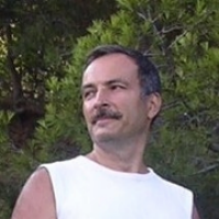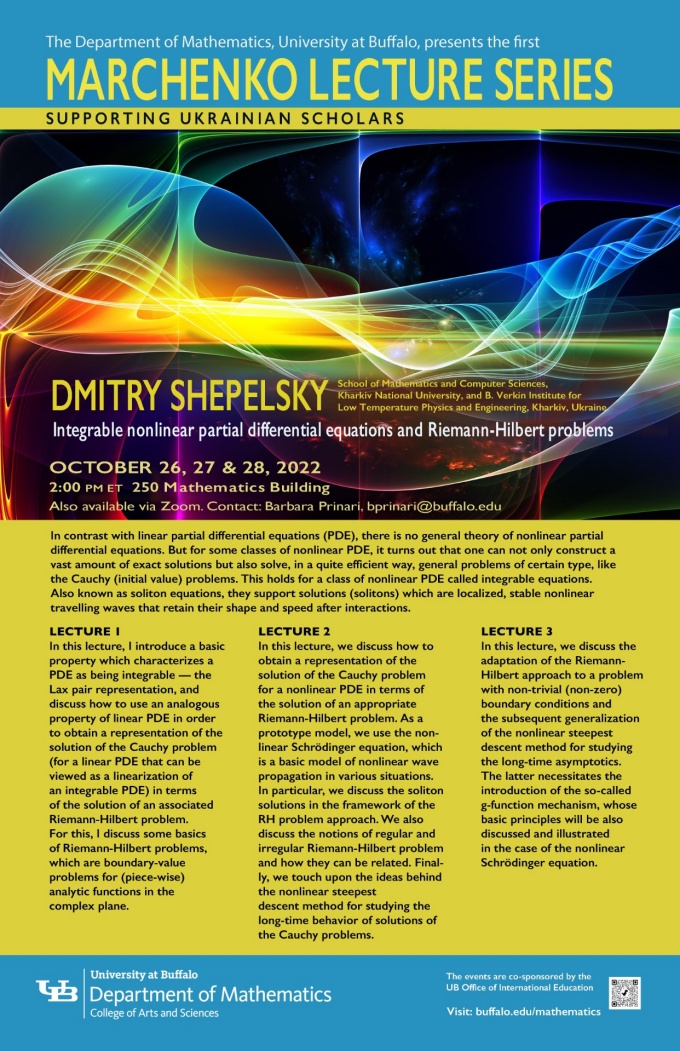October 26, 27 and 28, 2022
Marchenko Lecture Series

Supporting Ukrainian Scholars
Join us, October 26, 27 and 28, 2022, for our new lecture series named after Vladimir Marchenko, a Ukrainian mathematician who specializes in mathematical physics. Marchenko's seminal contributions to various domains, include: harmonic analysis and the theory of almost periodic functions; spectral theory of differential and finite difference operators; theory of inverse spectral and inverse scattering problems; spectral theory of random matrices of large dimensions; theory of electromagnetic wave diffraction on periodic structures; homogenization theory of boundary value problems in domains with complex microstructure; and, theory of integrable nonlinear evolution equations.
Particularly, Marchenko's solution of the inverse scattering problem for the Sturm-Liouville equation (“Marchenko equation”) has been a keystone for the development of the Inverse Scattering Transform method — a new direction in the theory of partial differential equations, known also as soliton theory.
This year, 2022, Marchenko celebrated his 100th birthday; he is still active — both in life and in his research. Unfortunately, because of the war in Ukraine, with the constant shelling of Kharkiv, he was forced to flee the city (where he spent most of his life) and settle in Canada.
The inaugural lecture series will be delivered by Dmitry Shepelsky, PhD, Mathematical Division in the B. Verkin Institute for Low Temperature Physics and Engineering, National Academy of Sciences of Ukraine, Kharkiv, Ukraine. The Marchenko Lecture Series is sponsored, in part, by the UB Office of International Education, Rapid Grant for Global and International Research.
Contact: Dr. Barbara Prinari, bprinari@buffalo.edu

Dmitry Shepelsky, Mathematical Division in the B. Verkin Institute for Low Temperature Physics and Engineering, National Academy of Sciences of Ukraine, Kharkiv, Ukraine.
October 26, 27 and 28, 2022
Dmitry Shepelsky
Integrable nonlinear partial differential equations and Riemann-Hilbert problems
October 26, 27 and 28, 2022
Wednesday, Thursday, Friday
2:00 p.m. ET
250 Mathematics Building
Also available via ZOOM
Contact Dr. Barbara Prinari, bprinari@buffalo.edu
ABSTRACT
In contrast with linear partial differential equations (PDE), there is no “general theory” of nonlinear partial differential equations. But for some classes of nonlinear PDE, it turns out that one can not only construct a vast amount of exact solutions but also solve, in a quite efficient way, general problems of certain type, like the Cauchy (initial value) problems. This holds for a class of nonlinear PDE called “integrable equations”. They are also known as “soliton equations”, because they support solutions (solitons) which are localized, stable nonlinear travelling waves that retain their shape and speed after interactions.
LECTURE 1.
Integrable nonlinear partial differential equations and Riemann-Hilbert problems. I
In this lecture, I introduce a basic property which characterize a PDE as being integrable – the Lax pair representation, and discuss how to use an analogous property of linear PDE in order to obtain a representation of the solution of the Cauchy problem (for a linear PDE that can be viewed as a linearization of an integrable PDE) in terms of the solution of an associated Riemann-Hilbert problem. For this, I discuss some basics of Riemann-Hilbert problems, which are boundary-value problems for (piece-wise) analytic functions in the complex plane.
LECTURE 2.
Integrable nonlinear partial differential equations and Riemann-Hilbert problems. II
Abstract: In this lecture, we discuss how to obtain a representation of the solution of the Cauchy problem for a nonlinear PDE in terms of the solution of an appropriate Riemann-Hilbert problem. As a prototype model, we use the nonlinear Schrödinger equation, which is a basic model of nonlinear wave propagation in various situations. In particular, we discuss the soliton solutions in the framework of the RH problem approach. We also discuss the notions of regular and irregular Riemann-Hilbert problem and ways how they can be related. Finally, we touch upon the ideas behind the “nonlinear steepest descent method” for studying the long-time behavior of solutions of the Cauchy problems.
LECTURE 3.
Integrable nonlinear partial differential equations and Riemann-Hilbert problems. III
Abstract: In this lecture, we discuss the adaptation of the Riemann-Hilbert approach to problem with non-trivial (non-zero) boundary conditions and the subsequent generalization of the nonlinear steepest descent method for studying the long-time asymptotics. The latter necessitates the introduction of the so-called “g-function mechanism”, whose basic principles will be also discussed and illustrated in the case of the nonlinear Schrödinger equation.
